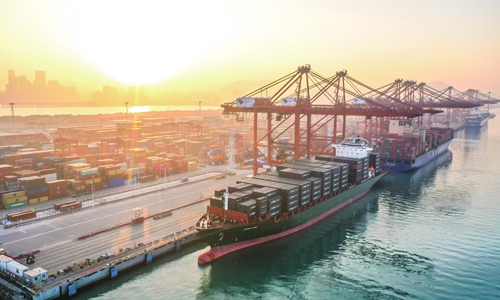For years, the Western perception of the Chinese economy has alternated between two extremes: either the Chinese economy is at the cusp of collapsing – the “China collapse” theory – or the Chinese economy is rising so rapidly that it poses a threat to the world – the “China threat” theory. There is virtually no middle ground between the two totally contradicting narratives, though both serve the same goal – smearing China’s socialist market economic system. Western media outlets switch between the two narratives at different times to best serve that goal.
Such a twisted, malign practice cannot be clearer than what we have seen over the past several weeks, as China moved to downgrade its COVID response, went through a COVID infection peak and embarked on a rapid economic recovery in such a short time span. The transitions happened so swiftly that the shift in Western media outlets’ narrative of the Chinese economy could barely catch up. Before the Chinese Spring Festival holidays, many foreign media outlets made grim predictions about China’s epidemic situation and economic recovery. Bloomberg on January 20 predicted a “COVID catastrophe” during the Chinese New Year, while CNN on January 18 claimed that a “COVID-19 tsunami” was brewing in the countryside amid the holiday travel rush.
However, as China witnessed what officials called a stable and orderly epidemic situation during the holidays and a better-than-expected rebound in travel and consumption, foreign media outlets have again shifted gear to focus on the “China threat” theory. CNN on Friday declared that “China’s reopening isn’t all good news,” because China’s economic recovery, though providing a boost for global growth, “may also stoke inflation just as it has shown signs of falling back.” In an article almost identical to the CNN piece, Bloomberg on Tuesday said that China’s economic recovery could offset weakness in Europe and a recession in the US, but also that is the “next big threat to global inflation,” even as the US and other countries’ central banks are racing to bring it back under control.
Despite the profound contradiction behind such narratives, Western media outlets, being the professionals they are, often appear to be presenting logical arguments with seemingly credible information. However, a deeper look would reveal how biased they are and how they cherry-pick information that suits the narrative that suits them. They put China under the microscope to find ways to blame the country for problems the world faces, while turning a completely blind eye to the ineptitude and mistakes of their governments that caused these problems in the first place or exacerbated them. Yes, they do criticize their governments – but only when an opposition political party is in charge.
The latest narrative that China’s economic recovery is the “next big threat” to global inflation is another perfect example. On the surface, as these Western media reports claim, China’s rapid economic recovery does indeed mean growing demand for energy and other commodities and surging demand could mean higher prices. However, they often ignore why energy prices have been so high, especially in Europe, over the past year in the first place. It is the Russia-Ukraine conflict, which the US-led NATO provoked, and the West’s relentless and reckless sanctions against Russia that pushed up global energy prices – not surging demand from any particular country or region. Moreover, sky-high inflation in the US and Europe were direct results of their excessive stimulus policies – not the policies or performance of any country or region.
These articles grossly exaggerate the impact of China’s economic recovery on global inflation. China’s GDP growth rate in 2023, while widely expected to reach above 5 percent, is highly unlikely to significantly exceed the 6 percent growth rate in 2019 before the pandemic, let alone the 8.1 percent growth in 2021. In 2019, the global inflation rate was 3.5 percent, and in 2021, global inflation was 4.7 percent, according to the IMF. In 2022, the global inflation rate shot up to 8.8 percent, amid the Russia-Ukraine conflict, Western sanctions and the fallout of Western economies’ excessive stimulus since the pandemic. During the year, China’s GDP grew by 3 percent. So the assertion that China’s economic recovery this year is to blame for global inflation is just nonsense.
Contrary to what Western media outlets claim, China kept its inflation stable, while the US and Europe basically lost control. In 2022, China’s annual inflation rate was at 2 percent, while the US’ annual inflation rate came in at 6.5 percent and the EU’s was 9.2 percent. According to the IMF, in 2023, China’s inflation rate is expected to reach 2.2 percent, while that of the US’ will reach 3.5 percent and the EU’s will hit 6.8 percent. What’s worse is that the US, through its dollar hegemony, has been exporting inflation to other countries. That has been well documented. For example, in an article in July 2022, Bloomberg reported that “the US is exporting inflation, and Fed hikes will make it worse.”
What’s more ironic is that the sky-high inflation in the US was in no small part caused by a series of wrong policy steps, including the excessive money-printing to prop up the economy during the election year in 2020 and the failure to even recognize – let alone tackle – soaring inflation in 2021 just to avoid partisan attacks. Even when US policymakers moved to tame inflation, they did so in such a haphazard way that caused serious implications for other economies, especially emerging market economies. So who is to blame for surging global inflation again?
Clearly, China’s ability to overcome the recent epidemic situation in a stable and orderly manner and mount a stunning economic recovery has made many foreign China-bashers uneasy and even jealous, so they came up with all types of narratives and attack lines to smear China. But nothing will change the fact that China is making greater and greater contributions to global growth, while the US and its allies are exporting problems.
(Global Times)




